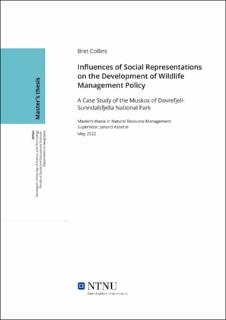| dc.contributor.advisor | Aasetre, Jørund | |
| dc.contributor.author | Collins, Bret | |
| dc.date.accessioned | 2022-07-19T17:23:20Z | |
| dc.date.available | 2022-07-19T17:23:20Z | |
| dc.date.issued | 2022 | |
| dc.identifier | no.ntnu:inspera:108357647:64544597 | |
| dc.identifier.uri | https://hdl.handle.net/11250/3007066 | |
| dc.description.abstract | Moskusen (Ovibos moschatus), også kjent som «Muskox» på engelsk og «Umingmak» på inuktitu (den skjeggete), er en taksonomisk unik arktisk planteeter funnet i polare områder rundt om i verden (Kutz et al., 2017). Moskusbestanden i Dovrefjell- Sunndalsfjella nasjonalpark i Norge ble satt ut på midten av 1900-tallet og er anerkjent av norske myndigheter som en introdusert art. Hensikten med denne oppgaven er å utforske forholdet mellom oppfatninger av moskusbestanden og forvaltningspolitikken. For å oppnå dette målet ble «Sosial Representasjonsteori» brukt for å forstå den sentrale kjerne og perifere elementer av representasjoner av moskusen fra perspektivet til tre sosiale grupper—parkbesøkende, parkforvaltere og turoperatører. For å komplimentere funnene fra den sosiale representasjonen, ble det også utført en tematisk analyse av styringsdokumenter knyttet til de innfødte moskusbestandene som finnes i Nord-Canada. En videre sammenligning illustrerer forskjellene og likhetene mellom måten ulike samfunn oppfatter moskusen på, der det ene samfunnet har interagert med moskusen over flere tusen år (kanadisk) mens det andre samfunnet kun har interagert med moskusen i under hundre år (norsk).
Synet på moskusen som et symbol på norsk reiseliv og på nasjonalparken er et sentralt tema i dette forskningsprosjektet. Denne forskningen avdekker at de `parkbesøkende ́ hadde en tendens til å assosiere moskusen med å ha en dypere mening enn det som ble sett i de sosiale gruppene `parkforvaltere ́ og `turoperatører ́. Til sammenligning, avdekker utforskning av de innfødte moskusbestandene i Canada at den kontinuerlige tilstedeværelsen av moskusene har ført til dyptliggende kulturelle tilknytninger. Innenfor disse samfunnene spiller moskusen ofte en essensiell rolle som ressurs for matsikkerhet i tillegg til å være knyttet til kulturell mytologi. Videre avdekker forskningen av de innfødte moskusbestandene i Canada også virkningen kortsiktig fjerning eller fravær av en art kan ha på kulturell verdi og tilknytning i et samfunn.
Forskningens funn viser at inkluderingen av lokale oppfatninger av en art i utviklingen av miljøforvaltningsplaner åpner for mer omfattende og inkluderende planer der Sosial Representasjonsteori vil være nyttig verktøy for å avdekke lokale oppfatninger. Gjennom å anerkjenne og inkludere den lokale oppfatningen av dyrelivet, kan fremtidige forvaltningsplaner oppnå høye nivåer av støtte fra lokalbefolkningen. | |
| dc.description.abstract | The muskox (Ovibos moschatus), also known as “Moskus” in Norwegian or “Umingmak” (The Bearded One) in Inuktitut, is a taxonomically unique herbivore, found in polar regions around the world (Kutz et al., 2017). The muskox population found in Norway’s Dovrefjell-Sunndalsfjella National Park was introduced into the national park in the mid 1900s. As the muskox population is recognized as an introduced species, the purpose of this thesis is to investigate the relationship between perceptions and management policy. To achieve this objective, ‘Social Representation Theory’ is utilized to understand the core and peripheral representations of the muskox from the perspective of three groups—park visitors, park managers, and tour operators. To compliment these findings, a thematic analysis is also conducted on management documents pertaining to the native herds of muskox found in Northern Canada. The comparison illustrates the differences and similarities between how different communities perceive the muskox, where one has thousands of years of interactions (Canadian) while another has less than a hundred years (Norwegian).
The view that the muskox is a symbol of Norwegian tourism and of the national park is a predominant theme in this research project. This research uncovers that the ‘park visitor’ tends to associate the muskox with having a deeper meaning than is seen with the ‘Park Managers’ and ‘Tour Operators’ social groups. In comparison, when exploring the native muskoxen populations in Canada, the continued presence of the muskox uncovers deep cultural attachments. Within these communities, the muskox often plays a vital role in providing food security resources as well as being tied to cultural mythology. The study into the native population in Canada also reveals the impact short- term removal or absence of a species has on cultural values and attachment.
This research has found that the inclusion of local perceptions of a species into the development of environmental management policy allows for more comprehensive and inclusive plans, with the Social Representations Theory being a powerful tool in determining local perceptions. By acknowledging and including the local perceptions of wildlife, future management plans can garner high levels of support from local populations. | |
| dc.language | eng | |
| dc.publisher | NTNU | |
| dc.title | Influences of Social Representations on the Development of Wildlife Management Policy:
A Case Study of the Muskox of Dovrefjell- Sunndalsfjella National Park | |
| dc.type | Master thesis | |
